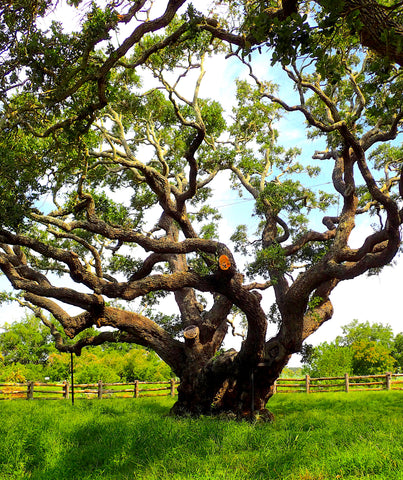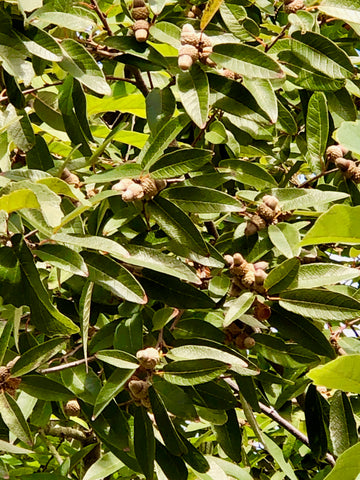Oaks & Acorns: The Mystery of the Mast
Did you know that the Oak trees of North America produce more nuts than any other tree region worldwide, cultivated or wild?
The fruit of an Oak tree is an acorn. A single giant Oak tree can produce nearly ten thousand acorns in a reproductive season. However, Oak trees do not bear fruit every year and some acorns require up to 18 months to mature. When a forest nut-bearing tree, like an Oak, Pecan, or Walnut, produces a high yield or bumper crop, the year is botanically referred to as a 'mast' year.

This 'Big Tree' is a coastal live oak, Quercus virginiana, and has lived more than a thousand years along the Texas Gulf Coast. Many of the surrounding oak trees are its offspring. How many mast years has this mighty tree experienced?
What is a Mast Year?
Mast is a term used to describe the fruit of forest trees and shrubs. The fruit can be hard nuts, like acorns or beechnuts, or soft, like blueberries or wild grapes, and are an important food source for wildlife. A mast year is when a particular woodland species produces more fruit than normal. Like many trees, Oaks have irregular cycles of high and low yields. Oak masting happens every 2- 5 years.
Why Do Oaks Mast?
Scientists are uncertain as to the exact reason why oaks and other plants mast but there is a range of theories from climate temperatures and rainfall amounts to harsh summers affecting acorn production or the availability of spring winds during pollination. The specific causes remain a mystery, but one undeniable evolutionary benefit of masting is... ensured future offspring.

Acorns are the easiest way to identify an Oak tree. There are over 600 species of Oak trees with more than 200 species endemic to North America. This elliptical oak shaped leaf indicates a Mexican White Oak tree and can be found growing as far south as Guatemala.
In mast years, acorns fall by the thousands increasing food availability for squirrels, mice, birds, and other forest frugivores. During mast events, dependent wildlife populations increase. The following year, the trees will bear little to no fruit due to the abundance of energy required to produce the previous year's bountiful harvest. In subsequent low to no yield years, wildlife populations decrease as food becomes scarce. Then in a mast year, the overflowing harvest will more than feed the forest critters and ensure some seeds left to grow into future oak trees.

Oaks in Peril
Imagine driving down a country road, sun shining, rolling meadows of green grass only to be delightfully interrupted by a large Oak tree standing gloriously alone. Romantic, yet a cause for concern. Many new Oak trees in the United States are planted on private properties. The forests are rapidly changing. Oaks are at risk due to logging, diseases, insect invaders, drought conditions, wildfires, and urban sprawl. When considering a new oak tree for your landscape, ask experts in your area which native oak tree species are dwindling in population and plant those species rather than the local garden center's popular oak trees. Together we can increase the diversity of the species simply by planting a rare native oak in our own gardens. And that's garden activism in action.
For more insight into the importance of Oak Trees, these recommended books are insightful and informative. Each book supports independent book stores in partnership with Bookshop.org A purchase helps support the journey at no additional cost to you.
18 comments
I came across the term “Oak Mast” when searching for a professor’s research publications, which ended up including any published document with the professor’s name including dissertations for doctorate degrees. My first thought when I saw the title of a dissertation was: “Why would anybody write a dissertation about sailing ship’s oak masts?” But from the rest of the dissertation’s title I realized mast was being used in a different way. So I did search on ‘oak mast’ and found this website’s page. Very interesting article. I had no idea there was a name for a year where an abundant crop was produced. Which is great because I say: “You need to learn something new every day or just die!”. It would be interesting to know how the word mast was applied to a very abundant production of the fruit of a plant. After all, how did a group of crows come to be known as a ‘murder of crows?’
Where we previously lived our neighbors to our left had a very large oak tree in their front yard. The trunk of the tree was about 16 feet or so from the property line between our houses But who knows how old that oak tree was because it had some limbs that hung over our property. There would be years when there would be a huge crop acorns. But the next two years had very skimpy acorn crops. Now I know why. Thanks for the article! Question: Do pecan trees have mast years?
Thank you for this information. I have two large oaks behind my backyard fence that usually drop hundreds of acorns in my yard. This year…….nothing! I thought maybe they were dying due to the severe drought in CA. Someone in my gardening group sent me your article as why this happens. Very interesting!
I have 2 oaks on my property and neither one has acorns ?? I live in SC
As harmful as intense wildfires are to oaks in some areas, it’s important to remember that more frequent, low intensity burns increase oak abundance in the Appalachians as oaks tend to be more fire tolerant than most of their non-oak competitors.
Our three largest oaks (Mabel, George, and The General Sherman) here in central NC are having a huge mast this year; it is raining acorns. My neighbor says she hasn’t seen this many acorns in the 30 years that she has lived here. We do our best to mow around the future generation and will relocate others to safer spaces. Trees are so good.